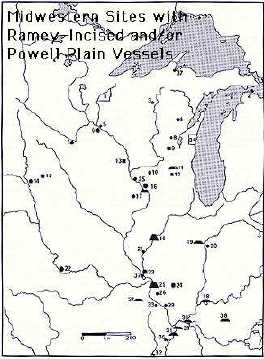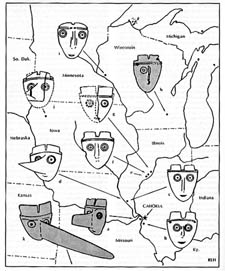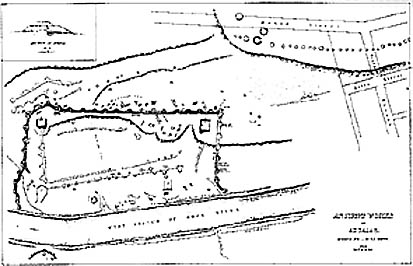 Sites with Ramey-incised and Powell plain ceramics:
evidence of socioeconomic interaction with the
Mississippian people of the American Bottom.
Sites with Ramey-incised and Powell plain ceramics:
evidence of socioeconomic interaction with the
Mississippian people of the American Bottom.

Sites with Long-nosed god masks: Shared art
style? Shared religious beliefs or cult? Or evidence
of the sociopolitical domination of Cahokia?
From a few floodplain sites on the eastern plains of present day Iowa, Minnesota, and Wisconsin
archaeologists have recovered a smattering of pots, points, pipes, and ornaments with strong Cahokia
affinities
![]() Ramey Incised and Powell Plain ceramics also occur in the large mound center of Spiro, Oklahoma,
as well as mound sites in the Lower Mississippi River valley such as Winterville and Lake George
Mississippi. Another item with strong ties to the American Bottom Mississippian, the Long-Nosed
God Masks are found as far away as northeastern Florida. The northernmost Mississippian mound site of
Aztalan is located in central Wisconsin. Catlinite, a material for pipes, was mined in the upper midwest.
Flintclay, a favourite material for figurines and pipes is also found in the Ozarks. Galena, or lead ore,
and copper also are known to have originated from the upper midwest and Great Lakes region. Other lead
sources are found in the Ozarks just west and southwest of the American Bottom. Mica from as far away as
central Appalachia was used for elite decorative items found in the American Bottom. Finally, marine
shell used in the manufacture of ornaments came from the Gulf of Mexico and the mid-Atlantic coast.
Ramey Incised and Powell Plain ceramics also occur in the large mound center of Spiro, Oklahoma,
as well as mound sites in the Lower Mississippi River valley such as Winterville and Lake George
Mississippi. Another item with strong ties to the American Bottom Mississippian, the Long-Nosed
God Masks are found as far away as northeastern Florida. The northernmost Mississippian mound site of
Aztalan is located in central Wisconsin. Catlinite, a material for pipes, was mined in the upper midwest.
Flintclay, a favourite material for figurines and pipes is also found in the Ozarks. Galena, or lead ore,
and copper also are known to have originated from the upper midwest and Great Lakes region. Other lead
sources are found in the Ozarks just west and southwest of the American Bottom. Mica from as far away as
central Appalachia was used for elite decorative items found in the American Bottom. Finally, marine
shell used in the manufacture of ornaments came from the Gulf of Mexico and the mid-Atlantic coast.
 Map of the Aztalan site, Wisconsin - an outpost of Cahokia?.
Map of the Aztalan site, Wisconsin - an outpost of Cahokia?.